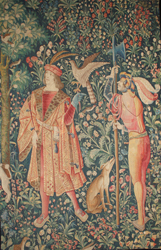Damage limitation for historic tapestries
The 'Monitoring of damage to historic tapestries' (MODHT) project involved experts in the fields of conservation science and textile and analytical chemistry. Researchers employed traditional techniques to produce model tapestries for use as scientific standards. The standards were used to develop physical and chemical markers for characterising fibres, dyes and metal threads. Analysis was undertaken on the microscale, linking chemical composition with the strength of the tapestry's fibres. Changes at the molecular level can identify the state of the fibre and a tapestry's overall strength, before any damage becomes visible. Microanalysis of products from the breakdown of dyes and mordants, used for fixing dyes, can also provide valuable information for researchers. Conventional acid extraction techniques for removing dyes from wool and silk fibres could not be used as they can interfere with the analytical process. Project partners from the University of Edinburgh used two-dimensional nuclear magnetic resonance (2D NMR) and liquid chromatography-mass spectrometry (LC-MS) techniques to identify suitable marker compounds. The marker was found to be dyed with logwood following the extraction of tapestry fibres. Furthermore, LCMS analysis identified a marker in fibres dyed with brazil wood. Both logwood and brazilwood are tropical trees from Central and South America that provide natural sources for dyes. Work undertaken by the MODHT project enables museum curators to have a better understanding of the condition of tapestries in their care. With this information they can make more informed decisions about preserving these unique cultural treasures.

